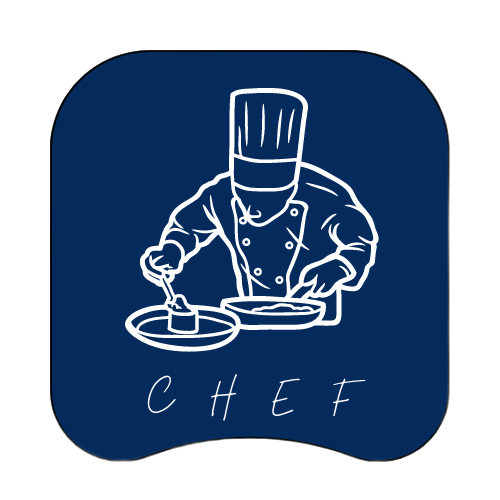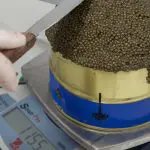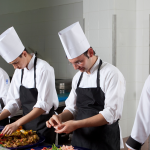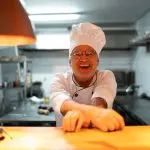What Is Gross Profit And How To Calculate The Gross Profit Sum
The Essential Skill That Chefs Need
What is the gross profit? Gross profit is the profit made from the total sales a company has made and then subtracting the costs of the products that have been sold.
Such as a street food business that has sold 10 burgers at £5 each equals £50 minus the cost of the ingredients for the 10 burgers which equals £20 the gross profit is £30.
Gross profit can also be known as – Gross Margin – Sales Profit or Gross Income.
Once a business knows the gross profit it is making it can then be turned into a Gross Profit Percentage to find out if the product is profitable enough for the business to sell.
In this case, the Gross Profit Percentage will be 60% which needs to be changed to around 75% to become a profitable product. This can be done by raising the prices, using more affordable ingredients and reducing wastage.
Why Do Food Businesses Use A Gross Profit Target %
It is important for food businesses to use a GP% target to be able to work out if a product will be profitable enough to use on the menu.
Within a catering business, there are many overheads and costs to consider. And these will be deducted from the monies that are taken.
Extra costs may include, staff wages, electricity, equipment, and insurance. A good GP% Target for a food business can be set at around 75%. A food business with a gross profit of 75% will be set on a good path.
What is Gross Profit Percentage – GP%
A gross profit percentage in a food business is the profit made on a menu item for example. As I mentioned previously a food business could be looking at a GP% of 75% this can be shown as:
A cost of a menu item is £2, this will be all the ingredients cost it takes to make the item. So to work out a 75% Gross Profit we need to calculate with a simple equation:
£2 x (4) = £8 – To get a Gross Profit of 75% we need to multiply the costs by 4.
This calculation can be used before an item is added to the menu. By knowing the product is profitable before we start selling it can set a food business up well.
What is gross profit?
The gross profit is the most important figure to calculate, and items should be priced accordingly.
The main reason a catering business needs to set a good gross profit target and stick to it is that there are a lot of expenses to account for. Consequently, all these expenses will be taken away from the gross profit, ultimately, determining the food businesse’s NET profit.
What Is Net Profit?
Once the gross profit has been calculated then the next job is to work out the net profit. This can be done by subtracting all of the costs from the gross profit number.
Net profit can also be known as the ‘bottom line’, net earnings or net income. And the net income will show how profitable a business is.
The Chef Dictionary – Words And Sayings Used By Chefs
To follow the common kitchen terms used by chefs in professional kitchens. When you work in a kitchen for the first time you will discover a lot of unusual words and kitchen terms. As a sous chef you master all these terms and sayings. Whether thats skills, foods or kitchen equipment.
Many of these words have been taken from the French language such as; mise en place and a la carte.
An a la carte menu is very different from a set price menu. Mise en place is a term I use as a chef which means a list of all the preparation work that needs to be done.
Learn What These Common Kitchen Terms And Sayings Used In Professional Kitchens Mean
Al dente, Baste, Blanch, Broil, Caramelise, Clarify, Deglaze, Dice, Dissolve, Dredge, Flambe, Garnish, Julienne, Parboil, Poach, Refresh, Saute, Score, Pane.
Kitchen Terms And Sayings 1 – 20
Key Words – Beurre Noir | Aromatics | Aspic
Ageing
Meats and cheeses can be aged. The food will be kept in a controlled environment over an exact time. This will bring out the natural flavours and helps in tenderising foods.
Al dente
Al dente is an Italian term used in pasta cooking. The pasta will be cooked to a slightly firm texture and will have a bite to it.
Aromatics
Adding flavours to foods, aromatics may include herbs, spices and vegetables.
Aspic
This is a meaty flavoured jelly. Once the aspic is cold it will set. It is used to add moisture and flavour to cold foods such as pates.
Bacteria
There are good types and bad types of bacteria. The bad bacteria are the ones that cause illness. Good bacteria, like the bacteria used in blue cheese, add flavour and colour.
To Bake
When baking a cake, it is known as baking. Other foods can be baked including; salt-baked fish. Where the food is baked in an oven.
Barbecue
Foods being grilled over an open charcoal or wood fire.
Baste
Basting is a cooking word meaning; to spoon juices, fat or liquid over food whilst it is still cooking. This helps to keep the ingredient moist.
Batter
You can create a better for various purposes, such as baking a cake or preparing battered fish or vegetables. For example, cake batters, beer batters or tempura which are a mixture of flour and other liquids. Additionally, each type of batter is tailored to suit it’s specific use, whether for sweet desserts or savory dishes.
Beat
Mix with a spoon, spatula or an electric mixer rapidly.
Beurre Noir
Heating the butter until it is dark brown in colour.
Bisque
A shellfish soup often uses lobster, it can be thickened and cream added at the end.
Blanch
Means to part boil a vegetable until it is half cooked in boiling salted water. The food will be placed in iced water to cool once blanched.
Blend
Blending two or more ingredients into an even mixture. Commonly being done with a stick blender or thermomixer.
Boil
Liquids are heated to 100 degrees Celsius and left on a rolling boil.
Bouillabaisse
This is a fish soup with tomatoes, fennel, wine and saffron added.
Bouquet Garni
A bunch of seasonings tied and left to flavour soups, braised foods and stocks. Such as; bay leaf and thyme, tied in a leek leaf.
Braise
A food slowly cooked submerged in a liquid. Braised foods can include; pork belly, shin of beef or leeks.
Breaded
Foods coated in breadcrumbs.
Kitchen Terms And Sayings 21 – 40
Key Words – Butterfly | Caramel | Clarify
Brown
Browning can be done at the beginning of cooking or at the end depending on the dish. The outside will be browned to add flavour and look great.
Brush
Coating foods using a pastry brush with butter or a glaze.
Buttercream
A frosting for cakes made from sugar, butter, eggs and flavours being added.
Butterfly
A chicken breast will often be butterflied. The breast will be cut down the centre but not completely cut in half and opened up.
Calamari
The word calamari has the same meaning as squid
Caramel
Sugar that has been cooked down to a dark brown colour. Often used in pastry, such as a crème Brulee topping.
Caramelization
Many foods can be caramelised when the natural sugars are released and cooked down. This is what gives onions or carrots the golden dark colours when cooked for a long period of time.
Chicory
A small lettuce often used in salads needs a good dressing or to be grilled as it can be very bitter.
Chiffonade
Cut lettuce or herbs into thin strips
Chinoise
Used to remove small particles of food from soups or sauces. It has a fine mesh fitted in a conical shape.
Chop
Foods are cut into rough pieces with no set size.
Clarify
Making a liquid clear such as butter soups or stocks.
Coating
Another word used for the coating of food in breadcrumbs
Combine
Making a single mixture from several ingredients
Confit
Slowly cooking meat or vegetables in animal fat, oil or butter. Duck legs commonly use the confit method coming in duck or goose fat.
Concasse
Peeling, deseeding and dicing raw tomatoes.
Core
Removing the centre of fruits such as apples;
Cream
Beating ingredients together until light and fluffy, including butter and sugar for a cake base.
Crimp
Seals the edges of pies together, often using a fork to press, seal and leave a crimped edge.
Croquettes
A small breaded rolled fried food often ingredients are mixed with mashed potato.
Kitchen Terms And Sayings 41 – 60
Key Words – Curdle | Cure | Devil
Crush
Break food down into small pieces using a pestle or mortar or a rolling pin.
Cube
Cut ingredients into even sizes with the same size sides.
Curd
Tart filling made with eggs, sugar, and commonly lemon juice and zest.
Curdle
The separation of milk or cream when overcooked;
Cure – Curing
Marinate foods with salt, sugar and spices. Often used for gravadlax.
Custard
A mix of eggs, sugar and cream cooked with or without a bain-marie on low heat.
Deep-fry
Cooking foods in hot oil until golden brown
Deglaze
Dissolving the bits and juices stuck to the bottom and sides of a pan after cooking using a liquid such as red wine.
Devil
Adding a hot ingredient to a food such as cayenne pepper or tobacco sauce.
Dice
A uniform cut can be small, medium or large dice
Direct heat
The food is cooked directly over a heat or flame.
Dissolve
A dry ingredient that has been placed in a liquid and formed a solution with the liquid.
Dough
A mix of ingredients such as flour, water and a yeast. A dough is commonly used in making bread.
Dredge
Coating an ingredient in flour and knocking off the excess;
Drizzle
Trickling a liquid such as olive oil over a vegetable
Dust
Light coating a food with icing sugar or sprinkling flour over a work surface before working a dough
Egg wash
Used to coat baked foods before or during cooking.
Emulsion
A mix of oil and a liquid.
Filet
A meat that has been cut away from the bone.
Filet Mignon
The cut of meat from the small end of the beef tenderloin
Kitchen Terms And Sayings For Sous Chefs 61 – 80
Key Words – Flambe | Flan | Gratin
Fillet
The skill to remove the bones from meat or fish. And finish with the filet.
Filter
Removing the impurities from soups and sauces
Flambe
Setting fire to the alcohol in a food to burn off in flames.
Flan
An open tart made with sweet or savoury ingredients.
Flake
Breaking a food into smaller pieces
Fold
Gently combine two or more ingredients using a side to side action
Fondue
Hot creamy melted cheese mixture
Fricassee
Stewed foods cut into small pieces served in a thick white sauce, I make a great mushroom fricassee.
Frittata
A baked omelette that is served flat and is not folded
Fritter
A sweet or savoury food that is covered in batter and deep fried
Fry
Cooking food in hot oil until golden brown
Ganache
A coating made of chocolate and cream for cake decorating or making truffles.
Garnish
Decorating a dish with an ingredient from picked herbs to a tuille
Giblets
The insides of poultry including the gizzard can be used in a sauce
Glaze
Giving a food a shiny surface with a melted glaze such as apricot glaze
Gluten
Gives dough its elasticity
Grate
Using a grater to break food down into tiny pieces
Gravy
A sauce made from the drippings of the meat and thickened
Grill
Foods cooked directly over a heat can be on cooking racks or rods
Kitchen Terms And Sayings 61 – 80
Key Words – Hash | Hull | Julienne
Grind
Break food down into small pieces using a machine
Herbes de Provence
A mix of herbs that have been blended and commonly used in southern France.
Hors d’Oeuvres
Another word for canapes
Hull
Taking out the stems of fruits including, olives and strawberries
Julienne
Cutting an ingredient into thin strips
Jus
The juices collected at the bottom of a roasting pan
Knead
Working a dough until it becomes smooth and elastic
Leavener
The ingredient that causes the rising process in baked goods
Line
Lining a tray with parchment paper or spray to prevent sticking
Loin
A part of the meat that comes from the back of the animal
Marble
Creating a ribbon effect in cooked foods
Marinade
A seasoned liquid used to marinate and enhance the flavour of foods.
Marinate
The process of using the marinade to flavour foods
Marzipan
A mixture of ground almonds, glucose and sugar used in pastry
Kitchen Terms And Sayings 81 – 100
Key Words – Medallion | Moisten | Papillote
Medallion
A small round portion of meat including pork or veal
Meringue
There are 3 types of meringue all using egg whites as a base ingredient
Mince
To break foods down into tiny pieces using chopping dicing or a mincing machine.
Mirepoix
Used to add flavour to sauces, onions, carrot, celery and leeks can all be used.
Mix
Combining two or more ingredients together until fully mixed
Moisten
Adding a liquid to a dry mix, just enough to slightly dampen the ingredient
Mull
Heating wine with spices, sugar and other juices.
Panfry
Adding food to a hot pan with a little oil and turning a couple of times to cook
Papillote
Foods are cooked in a packet made of parchment paper or foil. The food will steam in its own juices.
Peaks `
There are two main types of peaks, soft and stiff peaks. These peaks describe cream or egg whites that have been whipped up and used in many desserts.
Peel
The removing of the outer skin of fruits and vegetables.
Pesto
Traditional pesto is made with fresh basil, olive oil, garlic, toasted pine nuts and parmesan cheese.
Pickle
The method of preserving vegetables in a brine solution.
Pinch
Roughly the amount that can be held between the thumb and forefinger.
Kitchen Terms And Sayings For Sous Chefs 101 – 120
Key Words – Pit | Puree |Rolling Boil
Pipe
Piping cream or other soft foods through a piping bag.
Pit
Taking out the seed or stone from a fruit such as a plum.
Poach
A food is simmered in a liquid, such as a chicken breast just below boiling point.
Pressure cooking
Cooking foods in a sealed container using steam to create high temperatures.
Proof
The growth of yeast in a dough product before baking.
Punch down
After a dough has risen it needs to be knocked back by punching down.
Puree
A slightly thick sauce that has been passed through a fine mesh/ Chinoise.
Ramekin
A small dish often used to make a Brulee, suitable for use in the oven.
Reduce
Taking out the water content of liquids by boiling.
Refresh
Dampening or soaking vegetables with cold water to keep the freshly cooked appearance.
Render
Melting the solid fat on a food to a liquid fat and discarding or reuse.
Rest
For meats, resting a meat after cooking to keep the juices locked in before cutting
Rise
Leaving a dough in a warm place to increase in volume.
Roast
Cooking a food in the oven uncovered on a dry heat.
Rolling Boil
Boiling continuously and very fast
Roux
A mix used to thicken sauces or soups. Made of 50/50 flour and fat
Royal icing
The icing used for decorating cakes sets fast and becomes solid
Salamander
A gas or electric grill often used to toast or glaze foods
Sauce
A thickened liquid that adds flavour and wetness to foods
Sautee
Cooking a food with a small amount of oil over a direct heat quickly
Kitchen Terms And Sayings 121 – 140
Key Words – Season | Sift | Smoking Point
Score
Making a few shallow slits in fish or meats
Sear
Browning meat on the outside at a high temperature to add flavour
Season
Improve the flavour of foods by adding seasonings such as; salt, pepper and spices
Set
Food turns from a liquid consistency to a solid
Shred
Tearing food into strips, usually by hand. Such as a confit duck leg or a braised pork belly.
Sift
Passing dry ingredients including flour and sugar through a sieve to remove lumps.
Simmer
Heating a liquid to just below boiling point and adding foods to cook.
Skim
Taking the layer of fat that rises to the top of stocks, soups and sauces.
Smoking Point
The point when a heated fat starts to break down and smoke.
Steam
Cooking foods over a pan of boiling water or in a steamer.
Steel
The steel is used to sharpen knives.
Steep
Infusing dry ingredients in a liquid by soaking them possibly overnight.
Sterilize
Using steam, dry heat or boiling water to kill microorganisms
Stewing
Simmering meats/vegetables in a liquid over long periods of time.
Stir-Fry
Small pieces of meats or vegetables being cooked at a high temperature. Used a lot in Asian cooking often in a wok.
Stock
The liquid that is left after simmering bones such as veal or fish and vegetables.
Thin
Adding more liquid to a sauce to reduce the thickness.
Toss
Combining a mix of ingredients, often in a pan using an upward motion.
Kitchen Terms And Sayings 141 – 148
Key Words – Vichyssoise | Water bath | Zest
Truss
Tieing a roast together before cooking. This helps to keep the meats shape.
Unleavened
Goods that have been baked using no rising agent including, eggs or yeast.
Vichyssoise
A cold leek and potato soup, commonly known as vichyssoise, is a refreshing dish that is often served cold.
Vinaigrette
A dressing made with 1/3 vinegar to oil. Additionally, mustard and other seasonings can be added to enhance the flavour.
Whip
Mixing air into creams or eggs by whisking them vigorously until fluffy.
Whisk
The tool used for whisking. Used to whip creams and eggs.
Zest
The outer part of a citrus fruit. Often cut or peeled into strips.
he 14 Food Allergens Sous Chefs Need To Know
Getting to know the 14 food allergens is important for anyone serving foods. Food Allergies affect many people in the UK every year.
Some people will have a high-risk allergy, this means even the tiniest of the food allergen can cause a severe reaction and may also be fatal.
This can make the day to day life of a person with a food allergy very stressful.
All chefs need to be aware and trained in food allergens and understand what ingredients are in the foods they prepare
Foods That Cause Food Allergies To Be Aware Of?
The European Food Safety Authority requires clear labelling of specific foods on both pre-packed and non-pre-packed products. Chefs and food service workers must stay informed about these requirements.
There are 14 foods on the current allergen list, and chefs and catering business owners are responsible for identifying these allergens in every dish they prepare and serve in their establishments. Consequently, failure to do so can have serious consequences.
EFSA Food Allergen List
- Cereals Containing Gluten Such As Wheat (Such As Spelt ), Rye, Barley, Oats.
- Crustaceans, For Example, Prawns, Crabs, Lobster And Crayfish.
- Fish.
- Eggs.
- Peanuts.
- Soybeans.
- Milk.
- Tree Nuts, Such As Almonds, Hazelnuts, Walnuts, Pecan Nuts, Brazil Nuts, Pistachio, Cashew And Macadamia (Queensland) Nuts.
- Celery (And Celeriac).
- Mustard.
- Sesame.
- Sulphur Dioxide, Which Is A Preservative Found In Some Dried Fruit.
- Lupin Which Includes Lupin Seeds And Flour And Can Be Found In Types Of Bread, Pastries And Pasta.
- Molluscs, For Example, Clams, Mussels, Whelks, Oysters, Snails And Squid.
The business must clearly, concisely, and boldly label food allergens on pre-packed products, ensuring all allergen information and advice are prominently located in one place.
The 14 Food Allergens Training Courses
There is a large percentage of people in the UK who have an allergy to foods. The highest percentage of allergies involves gluten or wheat intolerance, with many people also being intolerant to some form of dairy.
Furthermore, according to a leading intolerance testing group, an estimated 4% percent of the UK has a high risk of serious food allergies.
As a result, EU Regulations have been updated on food allergens due to the rise in food allergies with the introduction of Allergen Awareness.
What This Means To Your Business
The new legislation means that all food businesses need to provide allergy information on all unpacked food sold. Such as a catering business serving bar snacks (sandwiches) and restaurant style dishes.
Secondly, there have been updates made to the current law on the labelling of allergenic ingredients in packaged foods.
Who Should Complete Food Allergies Training?
To meet the terms of the current EU Legislation, all food workers must have Allergen Awareness Training, so they have knowledge of food allergens.
For instance, people working in the food industry who should complete allergen training include:
- Chefs and cooks who are preparing unpackaged foods.
- People working in a hands-on job role in food manufacturing businesses including workers in a supervisory or management role.
Allergen Awareness Course Content
The allergen course will cover areas including:
- The Main Non-Food Allergens.
- The 14 Main Food Allergens.
- The Main Areas Of Food Hazards.
- How To Prevent Cross-Contamination.
- Separation Of Products.
- Labelling.
- Cleaning And Colour Coding.
- Cleaning Stages.
- Validation And Verification Of Cleaning.
- The EU Food Information Regulations, 2014.
- Allergens In Catering.
Food Allergies Course Test
The Allergen Awareness Test is a multiple choice test and has a total of 20 multiple choice questions. Also to gain a pass on the test, you will need to answer 15 or more of the questions correctly.
What does a la carte mean? A definition and meaning of the menu
When training to become a chef all chefs will need to have an understanding of the abilities to design and develop menus. This includes, the creating of dishes at precise costs to maintain a healthy budget. What does a la carte mean? And what is the price of the menu?
Restaurants typically use different styles to present the two types of menus: the a la carte menu and the fixed price menu (table d’hote)
The a la carte menu will have individually priced items at a higher quality and price than the fixed menu. The fixed menu, for instance, will feature a selection of fixed items offered at a set price.
Typically, this could include a choice of three starters, three mains and three desserts with two courses priced at £12 and all three courses priced at £15, In contrast, a la carte menus have individually priced dishes.
Furthermore, chefs will need to understand the different types of menus, how to correctly price the items, and how to design menus that make a profit.
What Does A La Carte Mean?
The phrase a la carte used in many restaurants comes from the French language meaning ‘according to the menu’.
The phrase “a la carte” entered the English language in 1826.
A la Carte Meaning And Definition
There are a number of different styles of the menu in a restaurant, one of the menus is an ‘a la carte menu’. What does a la carte mean? A la carte is a French language phrase that means ‘according to the menu’.
Another kitchen term is the phrase mise en place, this is the preparation for a specific section.
Generally, there are two types of menus in a restaurant the table d’hote menu and the a la carte menu. Also, these two styles on the menu will contrast each other.
The a la carte menu will have all the items priced separately and ordered separately.
The A La Carte Menu
These types of restaurants are high-end, high-quality establishments. They will have awards including AA rosettes and Michelin Stars.
What does a la carte mean for award-winning restaurants? For award winning restaurants, offering a la carte menus providing guests with the opportunity to choose individual dishes rather than fixed menus. Restaurants serving award-winning cuisines will not only feature outstanding dishes on their menus but also ensure exceptional service is provided by the front of house team.
What Is An AA Rosette?
The AA rosette system, which is a significant measure of culinary excellence, ranges from one rosette up to five rosettes. Furthermore, the higher number of rosettes representing greater achievements. Consequently, this system serves as a reliable guide for diners seeking exceptional dining experiences.
What Is A Michelin Star?
The Michelin award, another prestigious accolade, ranges from one to three stars, with three stars being the highest possible recognition for chefs. Furthermore, achieving Michelin stars often results in increased success for a restaurant and brings national recognition for the entire team. Including the chefs, sous chefs and heads.
Michelin Star Restaurants In London UK?
The UK is home to one of the worlds best culinary scenes, with London leading as a global hub for the hospitality industry. Additionally, the country currently boasts, nine 3-star Michelin restaurants and 27 two star Michelin restaurants. As a result, the UK has established itself as a prominent destination for food enthusiasts and industry professionals alike. Furthermore, there are numerous single star establishments, making the country a true culinary hotspot.
Other Establishments
The UK offers numerous opportunities across a wide variety of restaurants and businesses. As a result, the UK offers the opportunity for a fulfilling career. Therefore, chefs should aim to achieve a work life balance that aligns with their personal needs.
Moreover, in today’s world, pursuing a career as a chef no longer requires working excessively long hours every day. Instead, there are diverse options available to accommodate anyone aspiring to be a professional chef.


















